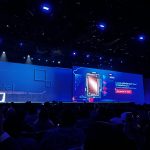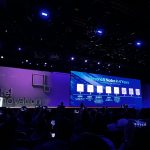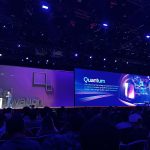Intel Innovation 2023 officially kicked off today, with media, analysts and Intel partners gathering from around the world. As always, the event started with a keynote from none other than Pat Gelsinger, Intel CEO. The running theme this year is undoubtedly AI, with Intel positioning itself to be a key leader in this rapidly growing computing segment. Specifically, Intel wants to enable developers with the tools to create locally run AI applications, enhancing user privacy and paving the road for AI enhancements for all kinds of use cases.
Gelsinger opened up his keynote with Intel's latest phrase – Siliconomy. Essentially, as Intel sees it, Silicon is set to drive the world's economy. Over the past five years, there has been a 4X increase in the number of connected devices and over the next ten years, that is expected to increase to 15X. This in turn opens up new opportunities for developers to grow, with a huge customer base to deliver new software innovations to. Intel hopes that its hardware and tools will be at the heart of all of that.
Love it or hate it, AI is the future, with the tech industry at large focusing keenly on taking advantage of machine learning and AI to enhance a number of industries. A few novel use cases for AI were demoed on stage today – the first comes from this year's Intel Ignite innovation winner, Deep Render, a company working on AI driven compression technology. Currently, Deep Render's algorithm has enabled 5X smaller video file sizes but they want to scale this up to 50X. In a comparison video shown on stage, we see a small video clip running in H.264 compared to the Deep Render compression solution and the results were quite impressive, delivering a notably sharper image with less artefacts, while also being 5X smaller than the H.264 video, which showed plenty of artefacting. The use cases here are numerous, with the ability to shrink download sizes. This could have huge implications for streaming services and media archives, reducing bandwidth use due to smaller file sizes, while also saving on space in data centres. If this could be applied to games, we may start to see a reduction in the number of 150GB+ downloads to more sensible numbers. Smaller files and higher quality should make everyone happy.
Another on-stage demo is a new app called Rewind. This is essentially an AI-powered digital assistant, capable of analysing your screen and audio to then assist you with finding information, recovering data, transcribing speech and writing emails. The key part here is that it runs locally, preserving privacy and security, rather than relying on cloud computing.
Intel has also focused a little on leveraging AI to improve human senses. In an example, we saw an app controlling a smart hearing aid, allowing it to adjust between focused and ambient modes. In focus mode, the user can block out more background noise to better hear their own conversation, but it can dynamically adjust to ambient if someone is trying to gain your attention. Gelsinger envisions a future where AI can be used to improve other senses too, with augmented reality-enabled glasses being an example but it is unclear how AI fits into that equation.
Intel will be looking to usher in the age of the AI PC, with efficient chips that can run local AI-powered apps later this year with the first Intel Core Ultra processors, arriving in December. This will be the first chip to use the Intel 4 node, packing EUV, foveros packaging, AI acceleration, WiFi 7 and a hybrid architecture with new P and E cores. In a demo, an Acer representative came up on stage with one of the first Intel Core Ultra-powered laptops. Using an application leveraging OpenVINO, the laptop was able to generate an AI image almost instantaneously, vastly speeding up stable diffusion.
Intel Core Ultra (Meteor Lake) is just the beginning though. Gelsinger and Co also gave us our first look at Lunar Lake, which is still pretty far off on the roadmap, but Intel already has systems running with these chips in place. In a demo using Audacity, a Lunar Lake powered system was able to quickly generate a song ‘in the style of' Taylor Swift. The lyrics were basically incomprehensible, but for a first demonstration, running locally on an efficient consumer-oriented system, it was a decent first showing. The Lunar Lake demo continued with text to image, leveraging AI through Gimp and OpenVINO to generate art at the click of a button.
Looking ahead, Intel's Arrow Lake processors utilising the Intel 20A node are on track, with silicon shown on stage today. In 2025, we will see Panther Lake, using the Intel 18A node, completing the company's mission of five nodes in four years.
On the Xeon front, Emerald Rapids will be with us in just a matter of months. The new-gen Xeon chips will be launching in mid-December, but Intel already has its sights set on 2024, with next year's Xeon upgrade, codenamed Sierra Forest, to bring new hybrid cores. Development is progressing ahead of schedule. Previously, we heard that Sierra Forest would offer 144 cores but Intel has since bumped that number up to 288, which is just a ludicrous number. This is achieved through two dies in one package, so it will be big, performant and naturally, expensive.
Intel began to fall behind in the node race a few years back and has since been working hard to rectify this and claw its way back into a leadership position. Looking ahead, Intel plans to introduce the first HI NA machines, which will replace EUV lithography.
Switching over to using glass substrates, Intel will be able to build more efficient and densely packed chips in future generations.
Currently, Intel is investing $100 billion into its fabrication facilities and as we saw with the launch of Intel Foundry Services, the company is looking to produce not only for itself, but for customers across the industry as well. In a Q&A after the keynote, Gelsinger noted that while Intel and Nvidia are competing in some areas, such as Intel's Gaudi AI accelerator vs. Nvidia's H100, they are still keen collaborators and partners in other areas. Gelsinger hopes that Nvidia will eventually be a Foundry Services customer and adopt the UCIe universal chiplet design, which is catching on with support from over 120+ companies.
All of this future-looking tech talk wouldn't be complete without touching on quantum computing. This is an area Intel has been working in for quite a while but in a twist, Intel is using Silicon qbits and is currently the only company to do so. If they can get this working, Intel could bring quantum-powered chips to the masses thanks to its ability to produce silicon on a huge scale. We're still some years off though, with Intel predicting quantum supremacy in the 2030s.
In the gallery below you can see all of our photos from the presentation. You can find the VOD, HERE.
KitGuru Says: Intel crammed a lot of announcements into a short 90-minute timeslot here. It went by fast, so it will take some time to digest all of the new information. Did any of you watch the keynote on the livestream? What do you think of Intel's latest developments and roadmap updates?
 KitGuru KitGuru.net – Tech News | Hardware News | Hardware Reviews | IOS | Mobile | Gaming | Graphics Cards
KitGuru KitGuru.net – Tech News | Hardware News | Hardware Reviews | IOS | Mobile | Gaming | Graphics Cards


































































